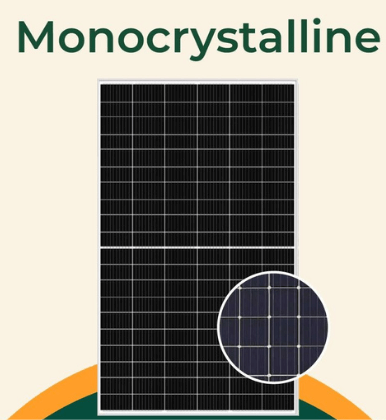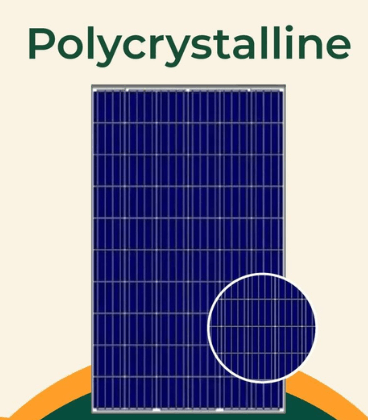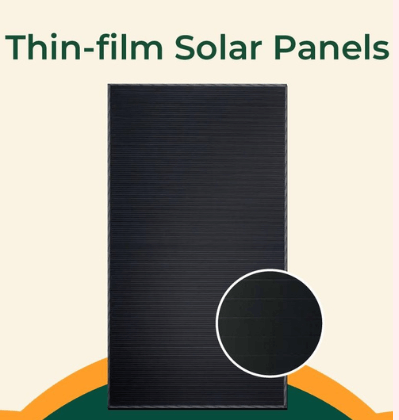Primary Types Of Solar Panels
How about getting solar panels for your home? It’s a smart move! Solar panel installation has perks like slashing your electricity bills, gaining energy independence, and contributing to clean energy. But before you dive in, there are a few things to consider, like how many types of solar panels are and how efficient they are, how they’ll look on your property, and, of course, the costs involved.
When buying solar panels, one of the key decisions is the type you go for. Your choice should align with your goals and what suits your situation best. This guide is here to help you understand the various types of solar panels, their advantages, and how to choose the perfect fit for your needs.
If you’re looking for an independent source of electrical energy, individual solar cells are a great option. These are small devices. Usually, a few square centimeters in size are covered with Glass or transparent plastic to shield them from environmental elements. Today’s solar panel designs are functional but also stylish and original, thanks to innovative minds working hard to make them both practical and good-looking.
A Complete Overview of the Different Types of Solar Panels
Around 2 watts of electricity will be made by a standard solar cell, which is 10 centimeters by 10 centimeters. As a result, the general design usually comprises several parts that are put together in a certain order. It is possible to make more electricity with this method.
How the solar panels are made.
Most photovoltaic or solar modules comprise 36 cells linked to each other. They are held up and able to work together by a metal frame. On the back of each panel are plugs that are a standard size. When we talk about an entire solar system, it might include many panels, a power system, an outside circuit, and batteries. Two main types of these batteries are those that work independently and those that connect to a network. In every case, experts use new technologies and creative ideas to make the solar panel. That way, you can be sure that a solar panel’s technical features and style work well together.
1- The self-sufficient device has a solar panel and batteries. Either the program or the load link is hooked up to them. The parameters of the PV panel set the parameters of each battery. Batteries store DC electricity with a steady load. For DC systems, the job of DC/DC adapters is to provide the proper voltage level. Off-grid systems are a great way to power a remote installation that can’t connect to a central power plant because it costs a lot. This answer lowers the chance of having to pay more. These systems can be used in many places, from lighthouses to homes in the woods. With solar cells that have a modern look, it’s possible to make the whole system and the outside of the house look good together. A skilled solar panel designer ensures the device works well, looks good, and doesn’t stand out from the style of a building or home.
2- Solar panel cells linked to the power grid bring together solar panels and the companies that run the power grid. How to do it can go one way or two ways. In the first case, we’re talking about how companies use systems to strengthen the power grid during the day’s busiest times. Bidirectional devices are used to provide businesses or people with electricity. They are known as grid-tied solar systems.
Any extra energy from solar cells can quickly be sent back to the public power source. It is also important to talk about the easiest and most common ways to place solar panels. Remember how the solar cells were laid out? For this, most of the time, an angled support frame or stand is used. Another name for this part is a fixed amount. But there are also more complicated ways to make panels bigger.
For example, they might have a motor and a tracking device that constantly moves the panels around. This method keeps better track of the Sun’s daily and seasonal movements, making the whole structure work much better. However, these solar panel tracking systems are pricey because of how complicated it is. Because of this, installing it is only sometimes a good idea. But you’ll be happy with how well it works at the same time.
The Three Primary Types of Solar Panels
Solar cells come in 3 main types. Let’s take a closer look.
Monocrystalline panels

Monocrystalline Panels are made from a single piece of silicon vs Poly which are made of fragments of silicon making them more energy efficient & durable. Because of how they are made, these panels will likely be the most expensive ones on the market.
The Czochralski method is the name for this method. A silicon crystal is set in a vat of hot silicon during this process. The crystal will then be carefully and slowly taken out by a professional so that the liquid silicon has time to harden into an ingot, which is the name for the crystal shell. Thin silicon plates are cut from this block and assembled to make a cell. The way these cells are set up makes a solar panel.
There are small gaps between the monocrystalline cells, which look like squares without edges when they are fully formed. Since these solar cells are made of pure silicon, they will look black. However, you can pick the frames and back sheets from different colors.
Polycrystalline Panels

Polycrystalline solar panels are becoming more famous because they work well. Sun panels that look like silicon are still used, but polycrystalline cells are made using a newer method. These panels are cheaper because they use silicon pieces instead of a single silicon crystal.
Pieces of a silicon crystal-melt together in a vat of hot silicon in this way of making things. Instead of slowly removing the crystal, experts will let it cool and break up. The silicon is cut into polycrystalline solar wafers and then put together to make a panel after it has cooled in its mold.
The cells will look blue if light hits polycrystalline crystals and bounces back. As you look at it in the Sun, pure silicon looks black, but broken silicon looks lighter and more blue. There are no holes between the square-shaped polycrystalline panels. Most of the time, frames will be silver.
Thin-film Panels

Passivated Emitter and Rear Cell (PERC) ( Bonus)
This kind of solar panel is brand new. Because of how flexible and easy to make, thin-film solar panels can be made from many different materials, not just silicon. They can be made from copper indium gallium selenide (CIGS), cadmium telluride (CdTe), and amorphous silicon (a-Si).
As part of this process, the material is placed between two thin sheets of conductive material. Glass is then put on top to cover it. A-Si solar panels are made of non-crystalline silicon with Glass on top.
This kind of solar panel is easy to spot because it looks thin. Thin-film panels are about 350 times smaller than solar panels made from silicon wafers. Even so, thin-film solar panels can have oversized frames that resemble the frames of the other two types. Different types of materials will give these plates different colors, but most of the time, they are black or blue.
Variations on Thin-film Solar Panels
Different kinds of thin-film solar panels can be made. Based on amorphous silicon, the CdTe shape is the easiest and least expensive to make. Solar panels with GIGS designs cost more, but people want them because they are considered higher quality.
No matter how much the panel costs, putting in a thin-film model may be less expensive than putting in a single-crystal or multi-crystal panel. The two examples mean that the construction process takes a long time because of how the panels are made. Also, installing thin-film CdTe and GIGS solar panel is more accessible because they are lighter and easier to move around.
PERC, which stands for passive radiator and back cell panels, is better than the old single crystal type panels. This relatively new technology works because solar power designs have a particular layer on the back that lets electricity pass through them more easily.
The ability of these panels to block light is what makes them work. This is because they can increase the amount of sunlight that is received. Because electrons naturally join with each other, the flow of electrons in the system slows down. Since the patterns are better, they can block longer waves of light. At the same time, the moving ball keeps the back sheet from getting too hot, which makes the panel last longer.
One of the best things about this type of solar energy design is that it works well in a small space.
Solar Panel Types by Efficiency
What kinds of panels are there based on how efficient they are? Here are some examples:
Crystalline solar panels are the most efficient of all the panel types.
- The efficiency of monocrystalline panels is over 20%.
- They are 5% more efficient than other panels because they have a passivation layer.
- Polycrystalline panels have a thickness of about 15 to 17 percent.
On the other hand, thin-film panels are typically only 2% to 3% less efficient than crystalline silicon panels. In general:
- CIGS panels are efficient in the range of 13 to 15%.
- CdTe is between 9 and 11 percent.
- At 6-8%, a-Si has the most minor effectiveness.
Panel type
PERC Highest Monocrystalline Polycrystalline Copper indium gallium selenide (CIGS) Cadmium telluride (CdTe) Amorphous silicon (a-Si) | Efficiency
5% 20% 15-17% 13-15% 9-11% 6-8% |
Solar Panel Types by Cost
Making monocrystalline panels, or modules as they are more commonly known, uses a lot of energy and doesn’t work very well because only half of the silicon crystals made are used.
Polycrystalline modules are less expensive because they use the leftover crystal pieces from making monocrystalline modules. This makes the manufacturing process more accessible and lowers the cost of production.
It costs the most for CIGS thin-film solar cells, CdTe, and amorphous silicon. Besides being cheaper to buy, thin-film modules may also be easier to set up because they are lighter and more flexible, lowering the work cost.
Over the last ten years, the total cost of domestic systems has decreased by more than 65%. However, the soft cost of a system has gone up from 58% of the total cost of the system in 2014 to 65% in 2020.
Panel (Module) type PERC Monocrystalline Polycrystalline Copper indium gallium selenide (CIGS) Cadmium telluride (CdTe) Amorphous silicon (a-Si) | Avrg Cost per Watt $0.32-$0.65 $1 – $1.50 $0.90 – $1 $0.60 – $0.70 $0.50 – $0.60 $0.43 – $0.50 |
Note: These prices exclude installation and labor. With labor and other overhead factors, the total can rise to $2.50 to $3.50 per watt.
Types of Solar Panels by Power Capacity
The power of a solar panel is directly related to how much it costs. The system as a whole will be more efficient as the unit power of each section goes up. The type of solar cells used can also change the size of the solar panel.
Solar panels usually give off 320 watts of power. This number can change most of the time. For example, batteries that can hold between 290 and 360 W are the most common.
Price-wise Classification of Solar Panel Types
As was already said, single-crystal individual solar cells and business-level choices like them are some of the most expensive. It’s essential to think about both the price of the solar energy plan and the total cost, including the installation cost. For instance, putting up thin-film panels might be cheaper than other choices. However, the price of these panels doesn’t always stay the same. Because of this, it’s important to think about how much it will all cost.
Comparison of Different Types of Solar Panels
- When looking for standard solar panels that work very well, monocrystalline types are what you should look for.
- When it comes to solar panel design, PERC is the right choice if you want modern and cutting-edge options.
- If getting the best deal is important to you, polycrystalline choices are good.
- And thin-film solar panels will work if you need new solar panels that don’t weigh much and are easy to set up.
Some Additional Factors About Different Types Of Solar Panels to Consider
Temperature
The temperature of a solar panels can change how much energy it can make. This drop in output can be seen in the temperature coefficient, which shows how much the panel’s output drops for every 1°C rise above 25°C (77°F).
It ranges from -0.3% to -0.5% / °C for monocrystalline and polycrystalline panels, and it’s closer to -0.2% °C for thin-film panels. Therefore, thin-film panels might be a good choice for places with hotter or more sunlight throughout the year.
Fire Rating
As of 2012, the International Building Code was updated to say that solar panels must fit the roof’s fire rating. This is to ensure that the units don’t make it spread faster if there is a fire. California goes even further and says that the whole PV system, including the racks, has to have the same fire rating.
Because of this, solar panels now have the same classification as roofs:
Type A
- Strong against intense fire test exposure
- The light should be at most 6 feet.
It is needed where wildlands and cities meet or where fires are likely hazardous and spread quickly.
Group B
- Good against mild fire test exposure
- The light should be at most 8 feet.
Group C
- Good against a light fire test exposure
- The flames shouldn’t go farther than 13 feet.
Score for hail
Additionally, solar panels are checked for damage from hail.
As part of the UL 1703 and UL 61703 standards, 2-inch solid steel spheres are dropped from 51 inches above solar panels, and 1-inch ice balls are fired from a pneumatic gun to make them look like they are being hit by hail.
Crystalline panels can handle hail, hitting them at up to 50 miles per hour because they are thicker, while thin-film boards have a lower grade because they are thin and flexible.
Hurricanes Rating
There isn’t an official solar classification rating for hurricanes. Still, the Department of Energy recently added more safety features to the design guidelines for solar panels to make them more resistant to bad weather.
These are the some suggestions
- These modules get the best ASTM E1830-15 grade for snow and wind loading in the front and back.
- Based on the DIN 65151 standard, fasteners that can lock in place
- The use of locking fasteners with through-bolt modules instead of clamping fasteners
- Using three-frame rail systems to make them more rigid and help keep them from bending
- Frames made of tubes over open-shaped C channels.
- Around PV systems with fences to slow down wind forces
Degradation Caused by Light (LID)
LID is a loss of performance that happens a lot in crystalline panels in the sun’s first few hours. This occurs when sunlight mixes with oxygen traces left over from manufacturing. This changes the structure of the silicon lattice.
The LID loss depends on how well the product was made and can be anywhere from 1% to 3%.
Which Type Of Solar Panels Should You Use
It’s also essential to think about the style of the building where the solar panels will be placed when choosing the style of the panels themselves. One of the most important things that decides the device’s technical specs is its solar cell power. In addition, the form of a solar array is essential because it determines how well this part of a building fits in with other parts of the building or object.
Limited Living Space
People who live in a crowded area with limited room should choose highly efficient monocrystalline modules to make the most of their space and save the most money on their utility bills. If you can afford it, getting PERC panels can lower the long-term costs of making energy even more.
Commercial Properties
People with sufficiently more significant properties can save money upfront using polycrystalline solar panels, where a larger panel size can compensate for a lower panel efficiency. It might be cheaper to get cheaper panels, but a more significant size could mean more work, so it’s not always the best deal. Even if the cost is low initially, it may be canceled out by lower efficiency and higher long-term running costs.
When it comes to thin-film solar panels, they work best in places where installing crystalline silicon panels would be too hard or take too much time. Some examples of these places are commercial buildings with limited room or thin roofs, small spaces like those for boats and RVs, and places that need flexible installation instead of rigid paneling.
Do not forget that solar panels are made to last for a long time, even up to 25 years. For that reason, no matter which type you pick, do your research to ensure it meets your wants.
Contact Our Friendly, Knowledgeable Staff
Solar Earth Inc., with expertise and certifications, empowers your home for enhanced energy generation. Contact us today to transform your home into a sustainable, long-term renewable energy source.
